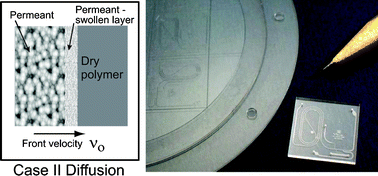Low-distortion, high-strength bonding of thermoplastic microfluidic devices employing case-II diffusion-mediated permeant activation†
Abstract
We demonstrate a new method for joining thermoplastic surfaces to produce microfluidic devices. The method takes advantage of the sharply defined permeation boundary of case-II diffusion to generate dimensionally controlled, activated bonding layers at the surfaces being joined. The technique is capable of producing bonds that exhibit cohesive failure, while preserving the fidelity of fine features in the bonding interface. This approach is uniquely suited to production of layered microfluidic structures, as it allows the bond-forming interface between plastic parts to be precisely manipulated at micrometre length scales. Distortions in microfluidic device channels are limited to the size scale of the permeant-swollen layer; 6 µm deep channels are routinely produced with no detectable cross-sectional distortions. Conventional thermal diffusion bonding of identical parts yields less strongly bonded microfluidic structures with increasingly severe dimensional compressions as bonding temperatures approach the thermoplastic glass-transition temperature: a preliminary rheological analysis is consistent with the observed compressions. The bond-enhancing procedure is easily integrated in standard process flows, uses inexpensive reagents, and requires no specialized equipment.


 Please wait while we load your content...
Please wait while we load your content...